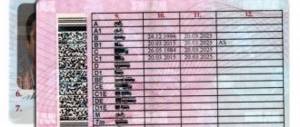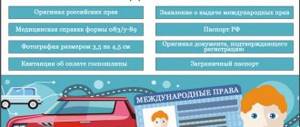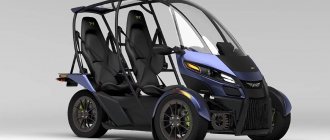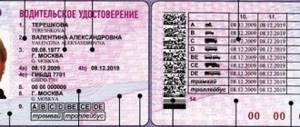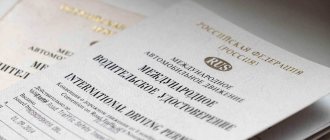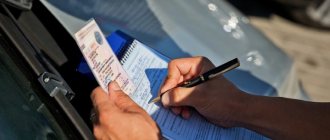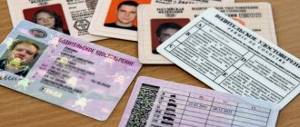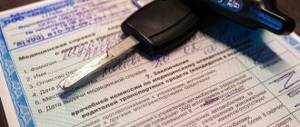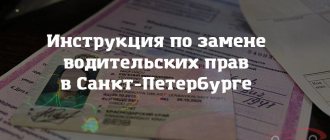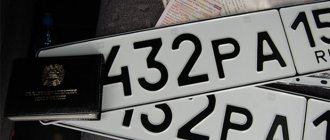What could be more important for a driver than the license that allows him to drive his vehicle. Today, this document is issued in a new plastic format, and this raises many questions among car owners. What must be indicated and what the strange abbreviations that appear on the back mean are just some of the innovations that interest drivers. For these reasons, it will be useful to decipher the new driver’s license.
The secret language of a driver's license.
We all know what the new type of license looks like. We know that on the front side of the license there is information about the driver, the place of issue of the document and open permitted categories for driving vehicles. But not many people know what the strange abbreviations on the back of their driver’s license mean.
And if everything is more or less clear based on the vehicle category marks, many drivers have difficulty deciphering incomprehensible abbreviations such as AT, MS, AS and others.
We at 1Gai.Ru decided to explain what these strange inscriptions on driver’s licenses mean.
The new driver's license has section 12, where, according to current legislation, special marks can be placed (opposite each open category and subcategories). Also, special notes in the form of abbreviations and explanatory notes can be included in section 14 (below the table of all categories and subcategories).
The procedure for placing marks on a driver’s license is regulated by Order of the Ministry of Internal Affairs of Russia dated October 20, 2015 No. 995 (as amended on September 6, 2017, as amended on October 25, 2018) “On approval of the Administrative Regulations of the Ministry of Internal Affairs of the Russian Federation for the provision of public services for conducting examinations for the right to drive vehicles and issue driver’s licenses.”
Decoding driver's license categories
Before you are given a complete breakdown of the driver's license categories, it doesn't hurt to know that many of them require separate training, but not all. For example, having passed the exam just once and received a document for any of the options presented below, the driver will automatically have the right to drive an ATV, scooter or low-power moped. It is the category that will determine the main classification of vehicles, in full accordance with their performance qualities and characteristics, as well as overall dimensions. But let's do everything in order so as not to get completely confused.
A (A1)
Understanding what it is, category A driver's license, you should know that it will allow you to drive all motorcycles, without exception, including vehicles with sidecars. Previously, you could often find motorized strollers on the roads, for which this category is also relevant, but today it is very rare. According to the traffic rules, motorcycles can include any vehicle, two-wheeled or three-wheeled, equipped with a side trailer (sidecar) or without one. This also includes four-wheeled vehicles that, when fully equipped, weigh no more than four hundred kilograms.
A1
Subcategory A1 includes all motor vehicles with an internal combustion engine volume of no more than one hundred twenty-five cubic centimeters. The maximum power of such devices should not exceed eleven kilowatts. It is clear that classification A will allow you to drive motorcycles, but not vice versa. The main attractive factor motivating drivers to obtain A1 is the opportunity to take exams not at eighteen, but at sixteen. More details about what categories A and A1 are can already be found on our website.
B (BE, B1)
This is a category of rights to a passenger car, the total weight of which, when fully equipped, does not exceed three and a half thousand kilograms. The number of seats in such vehicles should not be more than eight, that is, all passenger cars can be immediately assigned to this classification. There are several nuances that would not hurt to know.
- Category B makes it possible to drive a car with a trailer that weighs 750 kilograms or more, but only if the total weight is no more than 3,500 kilograms.
- This classification includes all passenger cars and light trucks.
- This also includes jeeps and small minibuses with no more than eight seats.
BE
In order to attach a heavier trailer to a vehicle, you will have to receive a new category - BE. This requires special, separate training, therefore, having a driving license with classification B, driving a car with a trailer weighing more than 750 kilograms is prohibited.
IN 1
Another subcategory B1 denotes quadricycles and tricycles. This is an absolute innovation, because many have not yet even figured out that we are not talking about ATVs, which are a motorcycle on four wheels. A quadricycle has a body like a car, but its motor power is no more than 15 kilowatts (20 horsepower). Moreover, such a vehicle can reach a speed of no more than 25-50 kilometers per hour. So, contrary to expectations, the motorcycle license (A, A1) will be completely useless here.
C (CE, C1, C1E)
This category includes all cars with a total weight exceeding 3.5 tons, with the exception of those that belong to subcategory D, which will be discussed later. In fact, this can include all trucks weighing from 3.5 to 7.5 tons, as well as larger ones, including those equipped with trailers weighing no more than 750 kilograms. But for passenger cars and light trucks up to three and a half tons, such licenses will be useless, and any traffic police inspector will classify driving in such a case as driving without a license.
SE
This category means driving trucks with a trailer weighing more than 750 kilograms. Without such permission, driving a vehicle with a large trailer is strictly prohibited.
C1
Subcategory C1 includes medium-sized trucks, the weight of which ranges from 3.5 to 7.5 tons, even with a light trailer (up to 750 kilograms). It is permissible to drive a car of this type, even if you just have a category C license.
C1E
If you need to drive light and medium-sized trucks with a heavy trailer, you will need a C1E license. However, here you will have to strictly ensure that the total weight of the structure (car with trailer) does not exceed twelve tons. There is nothing to do here with a regular truck license, but the senior CE category is suitable for driving such vehicles.
D (DE, D1, D1E)
A driver's license of this category is suitable for driving a variety of buses, the number of passenger seats in which exceeds the standard eight, as for B (excluding the driver). It will be valid both for tiny minibuses with twelve seats, and for huge tourist “monsters” with two floors. However, driving buses with an accordion or articulated with each other is prohibited with such qualifications.
DE
This category will allow you to drive buses with trailers whose weight does not exceed 750 kilograms. This also includes buses articulated with each other, forming a kind of road train.
D1
This category is issued to those who will transport people on buses with more than eight seats, but less than seventeen. It is permissible to use a light trailer (up to 750 kilograms). To illustrate what we are talking about, we can name the GAZelle-3221 or RAF-2203 model, which were previously widely used for minibuses. Now they have somewhat lost their relevance, but they have been replaced by imported minibuses with the same indicators.
D1E
This is a special qualification for small buses equipped with heavy trailers, the weight of which is not minimal (from 750 kilograms), but does not exceed the weight of the vehicle itself. The total weight of such a structure should not exceed 12 tons.
Please note that the trailer in this case cannot be intended for transporting passengers, but only for cargo, for example, luggage. It won’t hurt to know that if you have a D license, you can drive vehicles belonging to D1, and having a DE will allow you to drive D1E buses.
E
Deciphering the categories of the new driver's license allows us to say that classification E has been completely abolished and disappeared from this document. As you can see for yourself, all vehicles were simply distributed into other sections, for example, CE or BE, D1E or DE.
M
The category for mopeds and light ATVs was only introduced in November 2013. You can drive such vehicles if you have any other rights, and not just with this open classification. But neither the driver nor the tractor driver will be able to drive mopeds or scooters; he will need to open any other one of the above.
Tb and Tm
Previously, until 2021, the right to drive trams and trolleybuses, and this category concerns them specifically, could simply be found as a special mark, and there was no separate category for this. Now they are available, so you will have to get them if you are going to drive such transport.
In order to ensure that no one gets into an unpleasant situation, you need to clearly remember and know which vehicles you can drive specifically, and which it is better not to drive at all, even if you know how to drive them perfectly. To open any new category and some subcategories, you will have to undergo additional training at a driving school and pass exams as for the first time. Previously existing rights of a different qualification do not provide any advantages.
In what cases is the license marked?
If the driver has an open category “B” , but there is no category “A” in section 12 for the subcategory “B1”, the traffic police authorities put down the abbreviation “AS” , which indicates that the driver has restrictions for driving vehicles of the subcategory “B1” , equipped with a motorcycle seat, or if this type of vehicle has a motorcycle-type steering wheel.
For example, if you do not have category “A”, but category “B” is open, you have the right to drive tricycles and quadricycles , but only if these vehicles do not have a motorcycle-type seat and are not equipped with a motorcycle handlebar.
In what cases is the license marked?
This mark is placed on the driver’s license if the driver has an open category “A”, but no category “B” . The abbreviation “MS” is entered in the line for the subcategory “B1”. This mark confirms the driver’s right to drive vehicles of subcategory “B1” , but only those equipped with a motorcycle seat or a motorcycle-type steering wheel.
For example, in this case, the driver is allowed to drive tricycles and quadricycles that have a motorcycle riding position and are equipped with motorcycle steering. Accordingly, if your license says o (opposite subcategory “B1”), you cannot drive vehicles of subcategory “B1” that are equipped with a car steering wheel and do not have a motorcycle seat.
Contents of the old certificate
The following information was provided:
- series and individual number;
- Personal Information;
- place and date of birth;
- place where the owner is registered;
- date of issue of rights;
- the date when they expire and are subject to change;
- stamp of the traffic police department where they were issued;
- driver's signature;
- special marks.
As now, the document contained a photograph of the owner, which he provided when completing the documents. At the moment, a photograph is not requested, but is taken when issuing a license at the traffic police department itself or at the MFC center.
Type certificate 2011
At the beginning of 2011, a new type of license appeared in Russia. Now it has become a plastic card, similar to a discount card with rounded edges. Their size decreased and amounted to 856X54 mm.
An innovation was the expanded category “E”:
- category “BE” gives the right to drive a vehicle of category “B”, the total weight of which is less than 750 kg;
- category "CE" for drivers of category "C" trucks, but with a trailer, the total weight of the road train should not exceed 0.75 - 3.5 tons;
- category “DE” for public transport drivers with a total number of seats of more than 8;
- "tram" for tram drivers;
- “trolleybus”, respectively, for trolleybus drivers.
The first three categories deciphered in detail the previously known category “E”, which allowed driving vehicles of categories “B”, “C” and “D” with trailers.
Add. notes in rights issued since 2011
In the new document, released in 2011, a new column appeared - “special notes”. This is where the inscription “duplicate” is entered when re-registering rights in the event of loss, theft or rendering them unusable.
Notes about limited capabilities due to medical reasons appeared. If the driver has a physical disability, he must carry with him a medical document allowing him to drive. If a person wears glasses or contact lenses, then the corresponding mark is also placed.
There is a special one, respectively, provided to the owner, who is allowed to sit down at the equipment with this control option.
The “special notes” column was previously mentioned; data on driving experience, blood type and other necessary data that may be required by third parties during an inspection or in a critical situation are recorded here.
If a driver who holds one of these two types of licenses intends to travel abroad by car, he will have to obtain an international license.
Replacing rights
Once the statute of limitations has expired, the rights must be changed. But it is not necessary to do this at the traffic police. You can apply to change your rights through the State Services website. You select the point corresponding to the replacement of the driver’s license, upload scans of documents or high-quality photographs, choose a convenient traffic police point where you can apply for a new license when they are ready, and here you pay the state fee with a 30% discount. Filling out all forms and uploading documents will take an average of 30 minutes. The system will notify the applicant when the document is ready for issue.
The third way to replace your license is to personally contact the MFC with a package of necessary documents: old license, medical certificate, check for payment of the state fee. In this case, the rights will be issued within 10 working days, and you can pick them up when ready from the same MFC.
If you get your license again, you don’t need to go to a driving school or take an exam at the traffic police.
If the driver has any changes in his personal data, a change of license is required. A striking example is the change of surname when a girl gets married.
When you receive rights with new categories, study them. If it is discovered that the category of the vehicle does not correspond to the category of rights, a fine will be issued in the amount of 5 to 15 thousand rubles.
In what cases is the license marked?
This abbreviation is indicated for category “M” .
“ML” “M” vehicles .
Accordingly, even if you have an open category “B” , which automatically gives you the right to drive vehicles of category “M” , if you have an o on your license for category “M”, you do not have the right to drive vehicles of category “ M” , for example, driving a moped.
Categories
As a result of changes made to the legislation regulating road safety issues, namely Article 25, the previously existing categories were expanded. 10 main categories of driver's licenses began to operate and 6 subcategories of transport appeared.
The purpose of such changes is the appearance on Russian roads of new modifications of vehicles that have improved their functional characteristics.
“A” - makes it possible to drive a motorcycle with or without a tow hitch. The total weight of the equipment cannot be more than four hundred kilograms. The number of wheels doesn't matter.
Category B - the weight of the driven vehicle should not exceed 3.5 tons, and the number of seats for passengers should not exceed 8. Category B equipment can be equipped with a towed structure not exceeding 750 kg. This group also includes category M1, that is, passenger cars designed to transport no more than 8 people.
Category C - allows you to drive a car weighing more than 3.5 tons, with a trailer weighing more than 750 kg.
A citizen who has a category D license can transport people on a bus equipped with more than 8 passenger seats. In this case, a category D bus can be attached to a tow hitch weighing no more than 750 kg.
Mopeds and ATVs must be driven by a citizen whose license contains the M mark.
The vehicle group “Tb” trolleybuses and “Tm” trams, according to the new rules, are separated into a separate one.
The additional designation BE allows citizens who have the right to drive category B vehicles coupled with a trailer to get behind the wheel of a car.
Vehicles of category CE can be driven by a driver who has a license marked type C. The weight of the trailer is from 7,500 g to 3,500 kg.
Bus drivers carrying more than eight people can use a trailer weighing up to 3,500 kg (category DE).
What marks are put on a driver’s license in section 14
According to the current order of the Ministry of Internal Affairs, in section 14 of the driver’s license (on the back side at the bottom of the table with categories and subcategories of vehicles), marks are placed that relate to restrictions in relation to all categories and subcategories of vehicles. Also here information about driving experience is indicated, indicating the date of first receipt of a driver's license .
In what cases is the license marked?
This mark on the license means that the driver is allowed to drive vehicles of any category only if equipped with an automatic transmission (automatic gearbox). For example, o will be stamped by the traffic police if the driver passed the license exam in a car equipped with an automatic transmission .
It will also be indicated if the medical report on the driver’s permission to drive vehicles indicates that there are medical contraindications for driving a car with a manual transmission .
In what cases is the license marked?
This mark is opposite in meaning to the previous o. The abbreviation “MS” only allows driving vehicles equipped with a manual transmission. Please note: in contrast to the o for those drivers who took exams at the State Traffic Inspectorate in a car with an automatic transmission, if the exam was carried out on a vehicle with a manual transmission, the o is not affixed.
This means that in this case the driver is allowed to drive a car with either a manual or an automatic transmission. O is entered only if there are medical indications that allow driving a car exclusively with a manual transmission.
What does a car license look like?
The old type of paper ID was no longer issued in 2017. The new driver's license is made of plastic. This document is small in size (85 x 55 mm) and can be kept in a wallet or purse. All letters and numbers are clearly printed on a discreet light pink background.
The inscriptions on the licenses of the new format will not be erased over time.
The information can be read until the end of this sample document.
The entire plastic card is entangled in a fine mesh of wavy lines. This is one of the types of protection of a driver's document from counterfeiting. In addition, there is tiny text and images invisible to the naked eye. All necessary information is written on both sides of the certificate. An individual barcode is applied to the surface, readable during automated accounting.
Front side
In the center of the card, the name of the document is written in large letters - driver's license. In the upper left corner on the front side, the new international licenses are designated Russia (RUS) or the European Union (EU).
On the left is a color photograph without dark glasses or headdress.
An exception was made for Muslims and Jews for religious reasons.
All information about the car owner is indicated on this side of the new certificate in the form of a numbered list and is duplicated in Latin letters:
- Surname.
- First and middle name.
- Date and region of birth.
- 4 a – date of issue; 4 b – expiration date; 4 c – code of REO of the traffic police, which issued the license.
- Series and number.
- Photo.
- Driver's signature (as in the passport).
- Place of residence (large city or region).
- Open categories.
back side
The new driver's license has a table on the back. The first column lists the category designations. Types of transport are drawn next to them to decipher the markings. The second column indicates the date of opening of access, and the third - the closing date. The fourth column is used to record restrictions.
There is a barcode to the left of the table. It contains all the information about the driver that is in the electronic database.
The traffic police inspector, using a reading machine, can find out about fines. The driving experience of the owner of the new document is indicated under the table.
- Pain under the right shoulder blade
- 4 simple rules to avoid getting infected
- Why Soviet women had the thickest hair
Marks are also placed here about the permission to control with lenses or glasses, and the use of the car only with an automatic transmission. In the lower right corner, a four-digit series, a six-digit number is repeated. On the left is information about the manufacturer of the ID and the printing series. This serves as additional protection for the document.
In what cases is the license marked?
If an o was entered in section 14 of the driver's license, this means that the driver is allowed to drive a vehicle only equipped with sound parking sensors (acoustic parking system). Accordingly, if the vehicle is not equipped with such an assistance/safety system, the driver is prohibited from driving such a vehicle if equipped. Otherwise, the driver will face administrative liability for driving a vehicle without a driver's license.
In what cases is the license marked?
If the driver has medical indications for driving a vehicle only with the use of medical devices for vision correction, then the abbreviation “GCL” .
In this case, the driver whose license contains this mark does not have the right to drive without glasses or contact lenses. Without these medical products, driving a car will be considered illegal , that is, it is equivalent to driving a vehicle without a driver’s license, with all that entails.
What does a new driver's license look like?
Visually, the new driver's license looks almost the same as the previous prototype. The only thing that might catch your eye is an extended table of categories and several encrypted elements located on the back of the plastic card.
In addition, the national VU of the international format also received an enhanced security system, thanks to which it became simply impossible to forge a document. We will look below at where the secret signs are located on the crust and how they are correctly deciphered.
Appearance
On the front side of the new car driver's license, on the left side, there is an image of the owner of the document. Below, under the photo, there are two marks: 6 and 7, indicating the photo of the car enthusiast and his signature, respectively. In the center of the crust there is all the necessary data for identification (each column has its own serial number), as well as additional information about the length of service. In the upper left corner you can find a small protective sign with the abbreviation “RUS”, which changes color under ultraviolet radiation.
On the back of the driver’s license, almost all the space is occupied by a table of 16 categories, divided into 4 columns:
- Vehicle type;
- Date the category was received;
- Expiration date;
- Restrictions on a certain type of transport.
Immediately below it is mark 14, which contains general restrictions relating to all open categories, and some data about the previous driving license (this is where you can find the AT designation, which allows a citizen to drive vehicles exclusively with an automatic transmission. If such an abbreviation is present, driving a vehicle with a manual transmission is prohibited law).
In the left edge of the right of the new sample
A bar code has been placed for maintaining automatic records in the traffic police database. At the very bottom, the series and number of the certificate are stamped in red numbers, by which traffic police officers can calculate the MREO department where the document was issued, and the traffic cop responsible for this procedure.
Photo requirements
As with the previous 2014 VU, the European format crust must contain a photo measuring 21x30 mm. It is done in accordance with the following requirements:
- The person’s face is placed in the center so that there is 2-3 mm of empty space above his head;
- If the driver's new license states that he is fit to wear glasses, then he must be wearing them in the photograph;
- When photographing, the citizen does not smile, and his hair is styled so that the area above the eyes is open.
In addition, the image on the ID must meet generally accepted requirements for document photos (strict top, monotonous lighting, lack of makeup and other effects that do not allow a good look at natural features). Otherwise, the person will not be allowed to drive the car.
basic information
All basic information about the owner of the crust is located on the front side of the form, to the right of the photograph. It includes 7 main points:
- Driver's last name;
- His first and patronymic;
- Date of birth (allows employees to quickly identify the age of the motorist), official citizenship;
- The month and year of obtaining a driver’s license, its validity period and the name of the person responsible for issuing it;
- Document serial number;
- Place of registration of the owner of the VU;
- Open categories.
Using this data, the inspector can easily identify a citizen during a stop. In most cases, the above information is necessary for traffic police officers to draw up an administrative protocol.
In what cases is the license marked?
This mark on the license is affixed if the driver has medical indications for driving a vehicle using medical devices to compensate for hearing loss. For example, if during a medical driver's examination it is determined that the driver has a hearing problem, the medical certificate will indicate that permission to drive a vehicle is possible only with a hearing aid. It is on the basis of such an entry in the medical certificate that the State Traffic Inspectorate authorities put down the o .
see also
How traffic police officers tell drivers who use lenses instead of glasses
Traffic rules of the Russian Federation 2021
A driver's license is a document confirming the right to drive the relevant categories or subcategories of vehicles.
Order of the Ministry of Internal Affairs of Russia dated October 20, 2015 N 995 (as amended on September 6, 2017) “On approval of the Administrative Regulations of the Ministry of Internal Affairs of the Russian Federation for the provision of public services for conducting examinations for the right to drive vehicles and issuing driver’s licenses”
Currently, there are two types of driver's licenses in the Russian Federation:
- national driving license
- international driver's license
A national driver's license allows you to drive vehicles on the territory of the Russian Federation without restrictions, and you can also use it to participate in international traffic in those countries that have signed the Vienna Convention on Road Traffic, thereby recognizing the Russian national driver's license as valid for driving vehicles in their countries.
Countries that signed the 1968 Vienna Convention https://www.unece.org/trans/conventn/legalinst_08_RTRSS_RT1968.html:
Austria, Azerbaijan, Albania, Armenia, Bahamas, Bahrain, Belarus, Belgium, Bulgaria, Bosnia and Herzegovina, Brazil, Vatican City, Great Britain, Hungary, Venezuela, Vietnam, Guyana, Ghana, Germany, Greece, Georgia, Denmark, Democratic Republic of Congo, Zimbabwe, Israel, Indonesia, Iran, Spain, Italy, Kazakhstan, Qatar, Kenya, Costa Rica, Ivory Coast, Cuba, Kuwait, Kyrgyzstan, Latvia, Liberia, Lithuania, Luxembourg, Macedonia, Morocco, Mexico, Moldova, Monaco, Mongolia, Niger, Netherlands, Norway, United Arab Emirates (UAE), Pakistan, Peru, Poland, Portugal, Russia, Romania, San Marino, Saudi Arabia, Seychelles, Senegal, Serbia, Slovakia, Slovenia, Tajikistan, Thailand, Tunisia, Turkmenistan, Turkey, Uzbekistan, Ukraine, Uruguay, Philippines, Finland, France, Croatia, Central African Republic, Montenegro, Czech Republic, Chile, Switzerland, Sweden, Ecuador, Estonia, South Africa, South Korea.
However, not all countries have signed this convention and, accordingly, in these countries, our national driver's license may be considered invalid for driving vehicles, so in this case the driver must have an international driver's license.
Countries party to the 1949 Geneva Convention on Road Traffic https://www.unece.org/trans/conventn/legalinst_07_RTRSS_RT1949.html:
Australia, Albania, Algeria, Andorra, Argentina, Bangladesh, Belize, Benin, Botswana, Vatican City, Haiti, Gambia, Guatemala, Gibraltar, Hong Kong, Grenada, Dominican Republic, Egypt, Western Samoa, India, Jordan, Ireland, Iceland, Cambodia, Canada, Cyprus, China, Congo, Laos, Lesotho, Lebanon, Mauritania, Madagascar, Malawi, Malaysia, Mali, Malta, Namibia, New Zealand, New Caledonia, Papua New Guinea, Paraguay, Peru, Rwanda, San Lucia, Swaziland , Saint Vincent and the Grenadines, Singapore, Syria, USA, Sierra Leone, Taiwan, Tanzania, Togo, Trinidad and Tobago, Tunisia, Turkey, Uganda, Fiji, French Polynesia, Jamaica, Japan.
Countries party to the 1949 Geneva Convention on Road Traffic have the right to require foreign road users to provide an International Driving Permit (IDP), issued on the basis of the 1949 Geneva Convention on Road Traffic, which is the only recognized international driving permit that allows driving a vehicle in the territory of countries party to the Geneva Convention.
The national driver's license is issued for a period of 10 years, after which it must be replaced. An international driver's license can only be obtained if you have a national driver's license. An international driver's license is valid for three years and is valid only for driving outside the Russian Federation.
National driving license.
The description of the national driver’s license can be found in the order of the Ministry of Internal Affairs of Russia dated May 13, 2009 N 365 “On the entry into force of the driver’s license.”
The driving license (hereinafter referred to as the “license”) complies with the requirements for a national driving license under the Convention on Road Traffic 1968. The dimensions of the license are 85.6 x 54 mm (with rounded corners).
The certificate is made on a plastic base according to a sample approved in the prescribed manner.
The certificate has a front and back side.
The front side contains a protective background mesh having a smooth color transition from blue (left side) to pink (right side).
At the top of the front side there is the inscription “DRIVING LICENSE”, made in lilac.
On the left side of the front side there is a color photograph of the owner measuring 21 x 30 mm.
Above the owner’s photo there is an image of the distinctive sign of the Russian Federation “RUS”.
At the bottom of the front side there is a stylized image of a road with horizontal markings in gray.
The following information is indicated on the front side in the relevant sections:
1. Last name;
2. First name, patronymic (if available);
3. Date and place of birth;
4a) Date of issue of the certificate;
4b) Expiration date of the certificate;
4c) Name of the State Traffic Inspectorate unit (in coded form) that issued the driver’s license;
5. Certificate number;
6. Photo of the owner;
7. Owner's signature;
8. Place of residence;
9. Categories, subcategories of vehicles for which a license has been issued for the right to drive.
front side of the ID
The reverse side contains a protective background mesh, which has a smooth color transition from pink (left side) to blue (right side).
The left side of the reverse side contains a field measuring 10 x 42 mm for applying a barcode required for automated accounting.
In the lower right part of the reverse side there is a four-digit digital series and a six-digit ID number in red.
In the lower left part of the reverse side there is the manufacturer's output data.
The reverse side contains a table containing the following information:
in the leftmost column of the table - categories, subcategories and corresponding pictograms of vehicles for which a license can be issued;
in the column of section 10 - the date of receipt of the right to drive vehicles of the corresponding category or subcategory;
in the column of section 11 - the expiration date of the certificate for the corresponding category or subcategory of vehicles;
in the column of section 12 - restrictions on the right to drive vehicles of the corresponding category, subcategory of vehicles.
Section 14 indicates restrictions on the validity of the license that are common to all categories and subcategories of vehicles, as well as information regarding the owner.
back side of the ID
Restrictions indicated on the driver's license
Section 12 indicates the existing restrictions on the validity of the certificate in relation to the relevant categories and subcategories of vehicles.
If the license holder is granted the right to drive vehicles of the corresponding categories and (or) subcategories only with automatic transmission, o.
“A” in the driver’s license and there is no category “B”, in section 12 for subcategory “B1” an o is entered, confirming the right to drive vehicles of subcategory “B1” only with a motorcycle seat or a motorcycle-type handlebar.
“B” in the driver’s license and there is no category “A”, in section 12 for subcategory “B1” an o is entered, confirming the presence of restrictions on driving vehicles of subcategory “B1” with a motorcycle seat or a motorcycle-type handlebar.
If there are categories “A” and “B” in section 12 for the subcategory “B1”, no marks are placed.
If the owner of a certificate has medical restrictions on driving a vehicle of category “M”, an o is entered in section 12, confirming the presence of medical restrictions on driving vehicles of category “M” .
Section 14 specifies the general restrictions on the validity of the license in relation to all categories and subcategories of vehicles, information on driving experience (the year of the earliest date of obtaining the right to drive vehicles is indicated), as well as information relating to the owner of the license.
General restrictions on the validity of a driver's license in relation to all categories and subcategories of vehicles that are medical indications for driving a vehicle are indicated in coded form in Section 14:
MC - medical indications for driving a manual vehicle;
AT - medical indications for driving a vehicle with an automatic transmission;
APS - medical indications for driving a vehicle equipped with an acoustic parking system;
GCL - medical indications for driving a vehicle with the driver of the vehicle using medical products for vision correction;
HA/CF - medical indications for driving with the driver using medical devices to compensate for hearing loss.
A barcode is applied in a specially designated place on the ID, the contents of which are determined by the State Traffic Inspectorate at the federal level.
